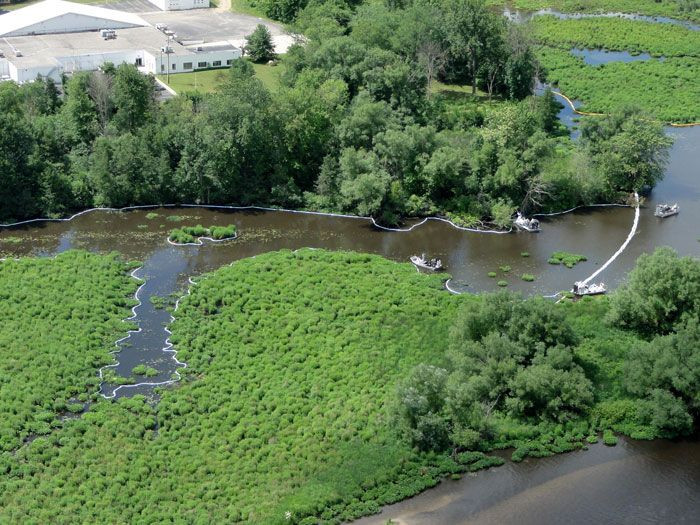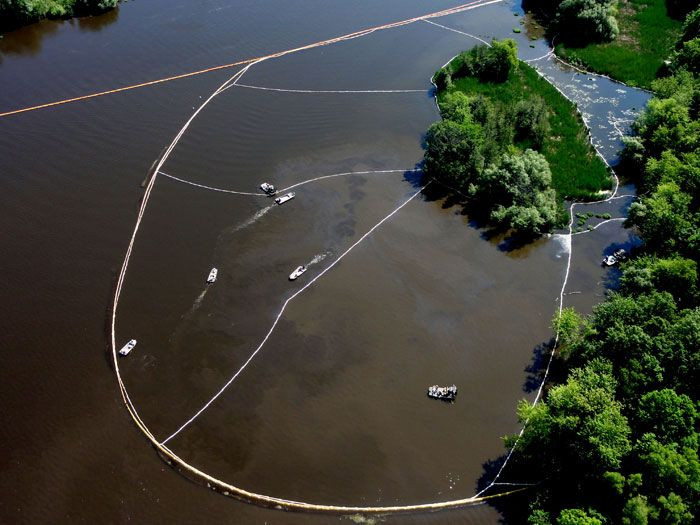Enbridge Oil Spill: Five Years Later, Michigan Residents Struggle To Move On

On the Kalamazoo River this weekend, Michigan residents will kayak down the sparkling waters and cast their lines for smallmouth bass. The relaxing summer day will bear little resemblance to July 25, 2010, when a ruptured pipeline spewed a million gallons of crude oil into a nearby creek.
Five years and billions of cleanup dollars after the worst inland oil spill in U.S. history, the river is largely revitalized. Resuscitated wetlands hug the river, while three new boat launches and man-made rapids draw paddlers, fishers and weekenders.
“We’re looking forward to promoting it as a destination, instead of it being a liability,” said Brad Wurfel, a spokesman for the Michigan Department of Environmental Quality, the agency leading the spill response for the state. “We’re proud of the cleanup effort here.”
Yet for many residents in southern Michigan, it feels like the spill never ended. Some say they worry the beautiful landscape belies the danger of chemicals and crude oil still lurking in the water. For others, the anniversary dredges up painful reminders of the day they were evacuated and their lives upended by the stench of oil and the noise of cleanup crews.
“It’s been a very traumatic time,” said Michelle Barlond-Smith, who lived in Battle Creek during the spill and moved away due to the disturbance. “It was horrendous. It was just a solid river covered in oil.”

The 2010 accident was disastrous not only because of how much oil spilled but also because of the type of crude running through Enbridge Inc.’s pipeline. Diluted bitumen, a particularly toxic crude from the Canadian oil sands region, is so thick and tarry that it must be thinned with volatile chemicals before it can flow through pipelines. Even then, the oil is too dense to float in the water, like conventional oil does when spilled. Instead, diluted bitumen sinks to the bottom, making it harder for workers to remove and retrieve.
“The Kalamazoo River still isn’t clean,” Anthony Swift, who directs the Natural Resources Defense Council’s Canada Project, told OnEarth magazine. “The EPA reached a point where additional cleanup might do more harm than good. Much of the river is still contaminated.”
Canadian crude oil spilled into the river for 17 hours before Enbridge workers could shut down the line. The Canadian energy giant has so far spent $1.2 billion to clean the 40-mile spill, an effort that wrapped up in late 2014. Enbridge and Michigan’s environmental agency will continue monitoring the river long-term for oil sheens, submerged oil and contaminated sediment, said Jason Manshum, an Enbridge spokesman.
The pipeline spill “was one of the bleakest and most humbling chapters in our company’s 65-year history,” he said by email. “We are pleased to have returned the Kalamazoo River to health, productivity and benefit to people and nature.”

Enbridge has paid nearly $90 million in fines so far for the spill, including settlements with state and federal agencies and Michigan landowners. The company also spent about $3 billion to build a 285-mile replacement pipeline, called Line 6B, which runs from Indiana, through southern Michigan to refineries in Ontario, Canada.
The firm’s bills may still be piling up. The EPA is considering imposing on Enbridge a multimillion-dollar for violating the Clean Water Act. The agency has until Friday -- five years after the violation occurred -- to levy the penalty, although the deadline may be extended.
An Enbridge spokeswoman said Thursday discussions on the penalty “are ongoing” between the company, the EPA and the U.S. Department of Justice.
Under the Clean Water Act, the EPA can impose fines of as much as $1,100 for each barrel of spilled oil. If the agency finds the spill resulted from negligence, the agency can impose a maximum penalty of $4,300 a barrel.
But questions remain over exactly how much oil spilled from the pipeline. The EPA has estimated that up to 1.1 million gallons (nearly 26,200 barrels) spilled in Michigan, while Enbridge and Michigan environmental officials put the figure at about 843,000 gallons (about 20,000 barrels).
By comparison, in the BP oil spill disaster, which happened just three months before the Michigan accident, more than 200 million gallons of crude pumped into the Gulf of Mexico.
Federal officials have still not determined whether Enbridge acted negligently when it operated the pipeline. Internal reports confirmed the pipeline had hundreds of corrosion defects in the years before the spill that Enbridge was attempting to repair. If the EPA rules negligence, and uses the higher oil-spill estimate, Enbridge could face fines of up to $112 million.
Barlond-Smith, the former Battle Creek resident, said she’s spending Friday on the Kalamazoo River with a group of local activists and residents. Their walk will begin in Marshall, the town closest to the spill, at a farm that was bought by Enbridge after the disaster.
“I want to be reflective of what has happened, but I also want to try and bring back some life into my city,” she said. “There’s a point in time where you have to mourn a loss, but then you also have to realize you’re still here. It doesn’t mean we’ll forget.”
© Copyright IBTimes 2024. All rights reserved.




















